No products in the basket.
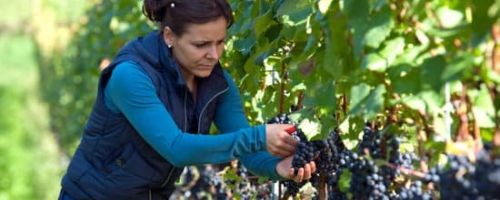
You may not pay too much attention to the specific origin of your wine but many consumers are increasingly concerned about the provenance of their wine just as much as they are about their food. So, you would think that a wine label would tell you exactly where your bottle of wine is from, wouldn’t you? The country and wine region that the wine is from should surely be given, maybe even the specific vineyard that the grapes were grown in for a more upmarket wine? But all is not as it seems on the origin of wine on some wine labels. Read about clues to your wine’s provenance from the wine bottle label and misleading terms on wine labels to look out for.
All wine bottles should give some indication of the provenance of the wine inside. Using France as an example, what you may see on the label may just be the country as in Vin de France, the general region as in Vin de Bourgogne, the more specific region, sometimes a village area such as Gevrey-Chambertin or even a specific vineyard as in Gevrey-Chambertin La Romanée.
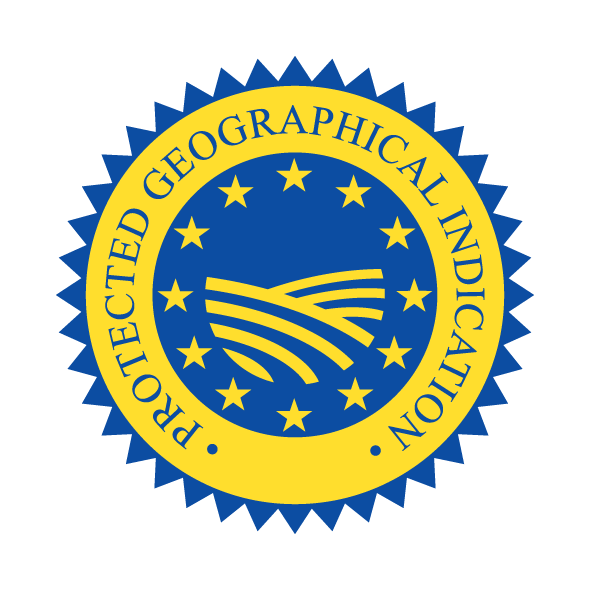
All of these classifications are known in the EU as Geographical Indications (“GI”) or appellations except for the country level Vin de France which is used for wines without a GI. The equivalent for wines without a geographical indication in Italy and Spain is “vino”, in Portugal “vinho”, in Germany “Deutscher Wein” and in Austria simply “Wein”. This means that Vin de France for example may include wine from different regions of France, wines that have failed to meet appellation regulations or wines that the producer prefers to market by its grape variety rather than by its origin. These latter wines tend to be simpler, consistent brands at lower price points.
In the EU there are two categories of GIs for wine: the general region level, e.g. Vin de Bourgogne, is known as a Protected Geographical Indication or PGI (logo on left) and the more specific geographical areas like Gevrey-Chambertin or Gevrey-Chambertin La Romanée are known as Protected Designations of Origin or PDOs (logo on right), essentially the appellations but the difference between the two is significant as you will see below.
Wine bottle labels displaying the region of origin of a wine will not necessarily include the country of origin. Some French producers for example may deliberately avoid using France on their labels in case their wine is confused with a Vin de France. Many producers choose to focus on the wine region and the chateau or winery name and so you might be expected to know that Fixin is in France (in the Côte de Nuits subregion of Burgundy) for example.
As a general rule, the more specific the location that a wine comes from, the better the wine is likely to be – and therefore the more expensive it is likely to be as well. A wine labelled with a specific vineyard name rather than just Vin de France should have been produced according to specific, tight regulations for that vineyard appellation.
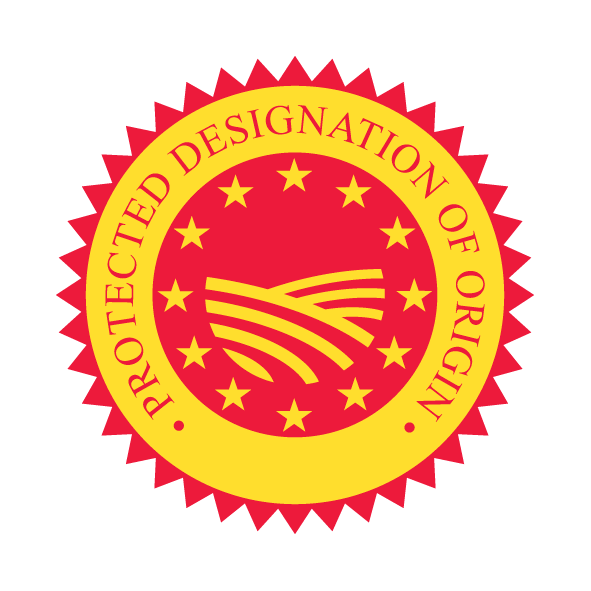
If you choose an EU wine from a PDO, like Gevrey-Chambertin or Gevrey-Chambertin La Romanée in our example, you can be sure that 100% of the grapes used for that wine will originate from the specific PDO area mentioned. It is like a guarantee for you when you want to know the provenance of your wine. You might expect that would be the case for all wines but in many countries regulations allow wine producers to declare a wine is produced in a certain region when only a certain percentage of grapes originates from that region or to state the wine is one vintage when it may be a blend of vintages or to advertise a wine as one grape variety when it may contain more than one.
In the EU a PGI wine also known as IGP wines (the old vins de pays) must have only a minimum of 85% grapes originating from the region on the label, 85% of any grape variety declared on the label and 85% of wine from the vintage on the label. Fattoria di Sammontana Sangiovese Toscana IGT above (not currently in stock) could have 85% to 100% Sangiovese therefore; in fact it has the same blend of grapes, 90% Sangiovese and 10% Caniolo Nero, as it had when it used to be a Chianti DOC.
I have focused so far on EU examples as these have more long-standing regulations; other countries are gradually adopting geographical indications but the rules are more diverse though several countries follow this 85% “rule” or similar.
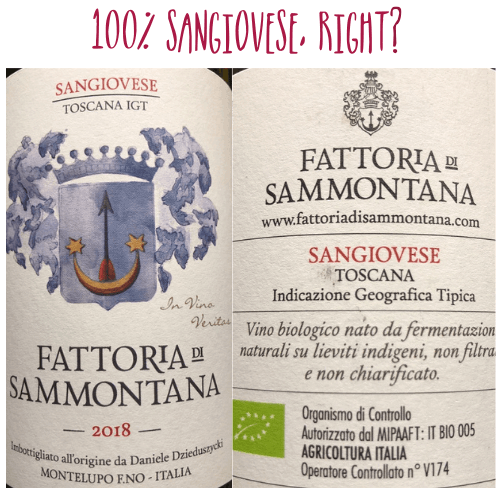
Like the EU PGI wines for example, Australian and New Zealand wines follow the 85% rule so a wine labelled as Australian Barossa Valley Shiraz 2019 need only contain 85% of grapes from Barossa Valley and only 85% need be from the 2019 vintage and only 85% need to be Shiraz. Wine producers may put 100% Chardonnay on the label if they want to erase any doubt about the contents of their wine. In Australia the geographical indication is not compulsory on the label which might indicate that a wine doesn’t have a minimum of 85% of wine from one region. Conversely it is possible to see a mix of geographical indications: according to Wine Australia, a wine produced from 83% Barossa Valley grapes, 13% Heathcote grapes and 4% Pemberton grapes would need to be labelled ‘Barossa Valley Heathcote’, Pemberton being excluded as it is below 5%.
The same 85% rule applies to South African wine but if a winemaker chooses to state “Wine of Origin Franschhoek” or “WO Franschhoek”, then 100% of the grapes must come from Franschhoek or whichever production area follows or precedes Wine of Origin or WO.
In the USA the minimum can be 75%, 85% or 100% depending on which American Viticultural Area or AVA, state or county is mentioned on the label. However the AVA need not be mentioned on the label although increasingly it is – fortunately. Working out a wine’s provenance can be a minefield.
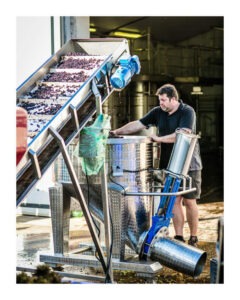 You may look for a particular château or winery name on the label to give you comfort about a wine’s provenance… but does it? The perception that the industry would like us to have is that all the wine we drink is produced with loving care from grapes grown on a chateau’s own land. But in by far the majority of cases this is not so. Not all wine grape growers produce and bottle wine. Many wineries buy in grapes from elsewhere to blend with their own grapes but this isn’t always clear to the consumer.
You may look for a particular château or winery name on the label to give you comfort about a wine’s provenance… but does it? The perception that the industry would like us to have is that all the wine we drink is produced with loving care from grapes grown on a chateau’s own land. But in by far the majority of cases this is not so. Not all wine grape growers produce and bottle wine. Many wineries buy in grapes from elsewhere to blend with their own grapes but this isn’t always clear to the consumer.
Here is Damien Landouar of Château Gaby getting up close and personal with the grapes at harvest time.
In actual fact many fine wines were historically shipped in bulk and bottled by merchants but this fell out of favour due to the risk – and practice – of fraud and the adulteration of wines. Wineries started bottling their own product in order to retain control over the contents in the wine bottle and to maintain their reputations; estate-bottled wine became and remains synonymous with quality.
Even if your wine is bottled by the winery or château on the label, can you be sure that the contents come wholly from their estate or vineyards? In theory, yes, as these terms are supposed to mean that the grapes come from the producer’s own vineyards and that the wine was produced on the producer’s estate. Some producers however prefer to make it absolutely clear – Francis Ford Coppola’s Inglenook winery’s 1882 Cabernet Sauvignon label states ‘Grown, produced and bottled by Inglenook’. Aurelio Settimo’s Langhe Nebbiolo label says ‘bottled by Aurelio Settimo’ and then explains that ‘This small, family-run farm vinifies grapes grown only on its own land’.
Similarly South African wine labelled as “estate wine” must be produced solely from grapes harvested on the estate in question and must be processed and bottled on the estate in question. The same grape harvesting restrictions naturally are in place for South African single-vineyard wines; the vineyards may not be larger than 6 hectares.
In the USA ‘estate-bottled’ is a legal term and the wine must be made from grapes grown on the producer’s land or in vineyards that the producer controls 100% by long-term lease or ownership and must be crushed, fermented, aged and bottled at the winery.
There can be no disputing the origin of the grapes in single-vineyard wines (to be covered in more detail in a future blog); their labels must state the vineyard name and the wines can generally command a premium.
Check labels for ‘British wine’ or for the ‘Bottled by…’ information – ‘mis(e) en bouteille par’ in French, ‘imbottigliato da’ in Italian, ’embotellado por’ in Spanish. The company or château listed on the label may not necessarily have bottled the wine.
As can be the case for many branded and more commercial wines, companies and supermarkets buy juice produced from grapes originating from any number of different vineyards from anywhere in the world to create their wine usually via factory-style, bulk production.
Some wine may be shipped in tanks and bottled in a different county altogether. Each year a whopping 600 million bottles of wine are bottled in the UK according to the Wine & Spirits Trade Association (“WSTA”). Given that English wine production in 2020 accounted for just under 9 million bottles, that’s a lot of non-English wine being bottled over here.
The trend for shipping wine in bulk has been on the increase mainly because it is much cheaper and more environmentally-friendly; this trend is driven by the increase in New World (especially Australian) wine imports. According to Wine Australia’s latest figures almost two thirds of Australian wine exports are bulk wine and by far the majority of that come to the UK to be bottled. It is therefore possible to have for example an Australian Shiraz bottled in the UK – but this must be declared on the label.
It used to be the case that juice and wine in tanks were more prone to oxidation and temperature fluctuations but technology has improved to reduce those risks and the wine can sometimes be adjusted prior to bottling to iron out small imperfections. Some argue though that bulk shipping can make wine taste flat – though I suspect the flat taste says more about the quality of the wine being shipped than about the conditions of transportation. Wine Australia reports that the average value of Australian wine shipped in bulk is AU$1.30 per litre compared to AU$6.69 per litre for Australian wine shipped in bottle.
At that low end of the market bulk shipping has its advantages as it keeps down the cost of the wine – so if you enjoy £7 bottles of wine it could be argued that you are getting better value in wines that have been bottled in the UK. Of course bulk shipping is not going to work, even if they wanted it to, for smaller wine producers.
Note that juice that is shipped to the UK to be made into wine in the UK ‘British wine’ as opposed to ‘English wine’ which is wine produced in this country from grapes grown here.
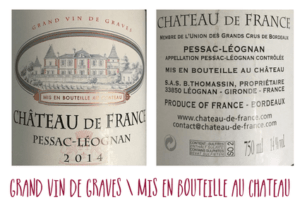 Grand Vins vs. Grand Crus
Grand Vins vs. Grand Crus
There may be terms such as “Grand vin de Bordeaux” or “Grand Vin de Bourgogne” on a wine’s label. This may sound prestigious but the term Grand Vin has no legal or universally-defined meaning; some might even say that the term is used to make the wine sound grander than it might actually be. Grand Vin should not however be confused with Grand Cru which is a term used in the Médoc and St Emilion classifications. Nor can I find a legal definition or regulations for the term “Fine Wine of ” on the above Boekenhoutskloof label.
Estate Grown
‘Estate grown’ is a term which has been used on labels in the past instead of estate-bottled but it is only seen occasionally these days – it means wine made from grapes grown in vineyards controlled by a producer who does not then crush the grapes and bottle the wine on his property.
‘Cellared by’ and ‘vinted by’ may be seen on wines from producers (usually in the USA) who don’t own a winery and / or where the wine has been aged before being bottled.
Ownership
You will increasingly see the name of the producer as well and the names of the importer and distributor of the wine on the label as wine associations want consumers to feel confident about their wine’s origins.
If you care about the provenance of your wine make sure you read the small print on the label. Though not necessarily better, an estate-bottled wine means that you can be sure exactly where the grapes in the wine originate from and the wine is generally a better representation of the terroir and vineyards and of the winemaker’s skill in the winery. And if your conscience tells you that you should be greener in your wine purchases, take some comfort from the fact that according to WSTA wine bottles are 30% lighter than they were 7 years ago, though in my experience there is definitely more that can be done there but that’s for another blogpost.
© 2014-2025 Wines with Attitude Ltd | VAT Reg. No. 181 2419 22 | Registered in England 08918466 | Fiveways, 57-59 Hatfield Road, Potters Bar, Herts, EN6 1HS